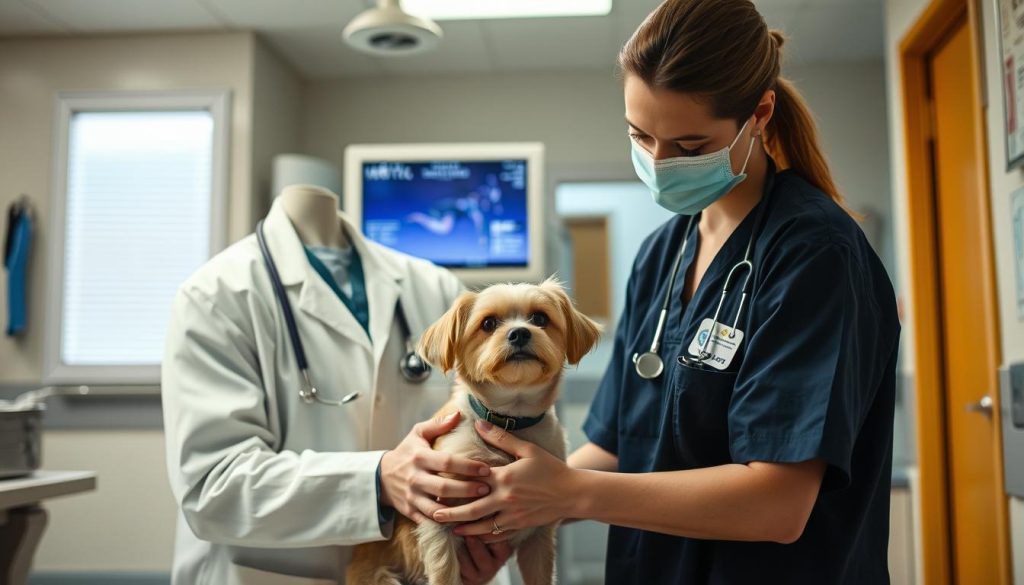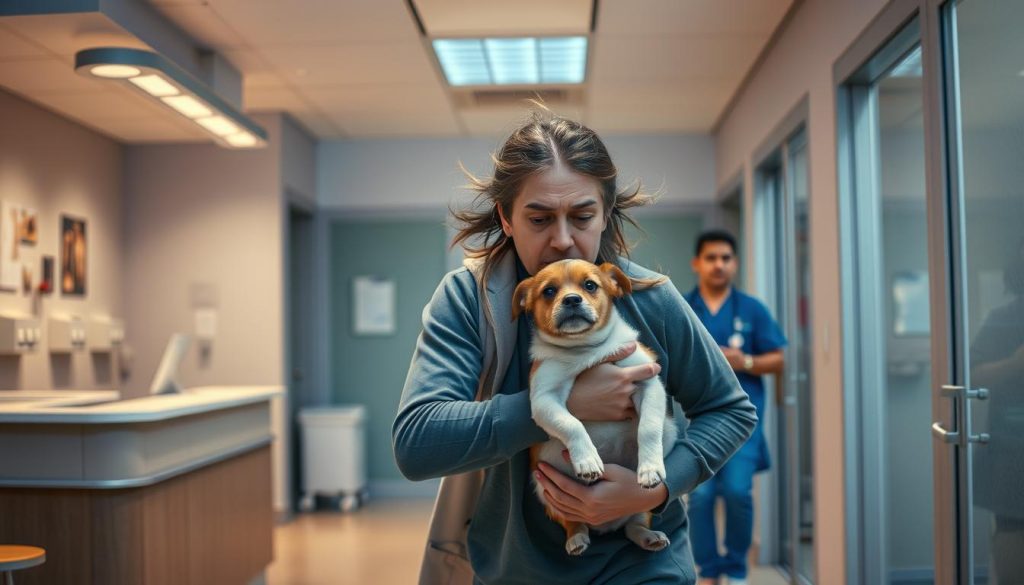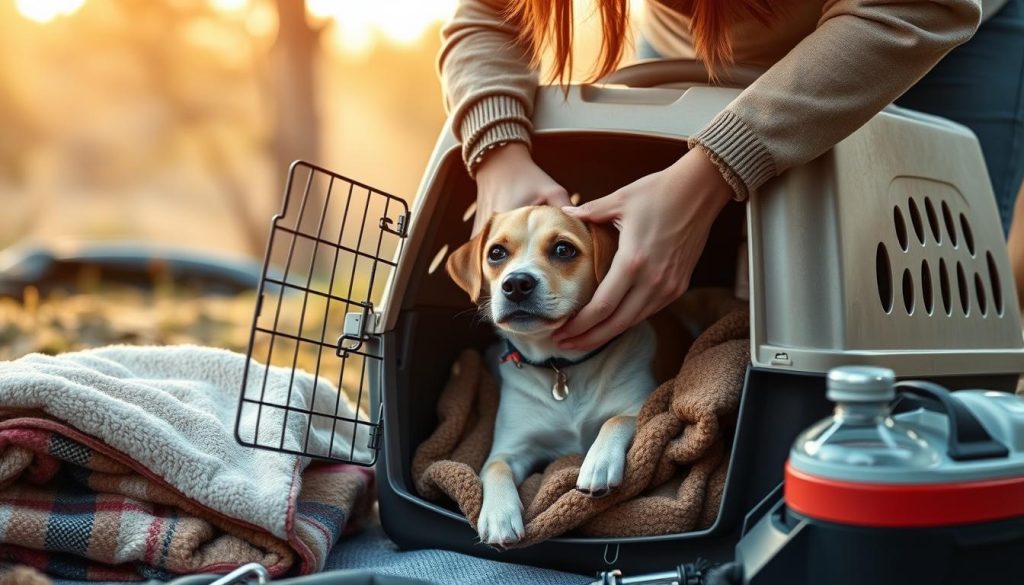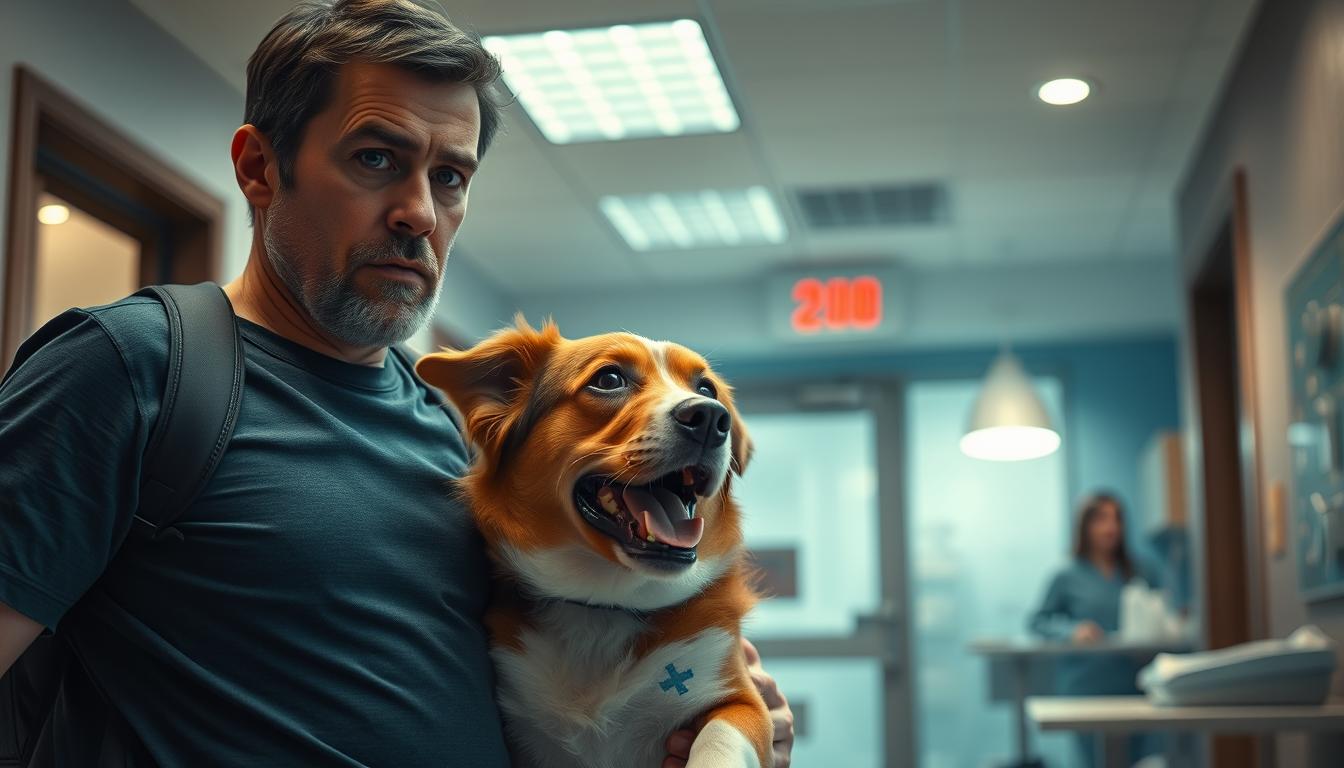As a pet owner, the wellbeing of my furry companion is very important. But, unexpected medical emergencies can surprise us, making us feel helpless. It’s key to be ready for those times when our pets need urgent care.
In this article, I’ll show you the basics of pet emergency care. We’ll cover how to spot signs of distress and handle emergencies calmly. This way, your pet will get the best treatment.
I want to give you the knowledge and confidence to act when your pet’s health is at risk. Whether it’s a serious situation or a small issue, knowing what to do can be a big help. Let’s dive into pet emergency care and make sure our pets get the care they need, no matter what.
Recognizing Pet Emergencies
As a pet owner, knowing the signs of distress and common medical emergencies is key. Spotting these issues early can save your pet’s life. Let’s look at the important signs and common crises.
Signs of Distress
When your pet is in distress, they may show several concerning symptoms. These include:
- Rapid or labored breathing
- Excessive vomiting or diarrhea
- Unresponsiveness or lethargy
- Sudden changes in behavior or mood
- Difficulty walking or standing
- Excessive whining or crying
If you see any of these signs, act fast and get vet care. These symptoms could mean a serious problem that needs quick help.
Common Medical Emergencies
Pet medical emergencies can vary, but some common ones are:
- Poisoning: Pets might eat something toxic, leading to severe illness or death.
- Trauma: Accidents or injuries can cause broken bones, internal bleeding, or other serious issues.
- Choking: Pets can choke on small items or food, needing quick action.
- Seizures: Conditions like epilepsy can cause seizures, which are scary and risky.
If you think your pet is having a medical emergency, stay calm and get vet care fast. Knowing the signs and common emergencies helps you care for your pet better.
Preparing for Pet Emergencies
Being ready can really help in urgent situations. As a pet owner, it’s key to have a good pet first aid kit. This kit should have things like gauze, antiseptic, and emergency contact info. These are important to have ready for emergencies.
Creating a Pet First Aid Kit
A good pet first aid kit has the tools you need for many emergencies. When making your kit, think about adding these items:
- Gauze pads and rolls for bandaging wounds
- Antiseptic wipes or spray to clean injuries
- Hydrogen peroxide for inducing vomiting (only when recommended by a veterinarian)
- Tweezers for removing splinters or ticks
- Scissors for cutting bandages or fur
- Thermometer to monitor your pet’s temperature
- Disposable gloves to prevent the spread of germs
- Emergency contact information for your veterinarian and local animal hospital
Having these pet first aid kit items ready can help you act fast in emergencies. Learn how to use them so you can help your pet when they need it most.
| Item | Purpose |
|---|---|
| Gauze pads and rolls | Bandaging wounds |
| Antiseptic wipes or spray | Cleaning injuries |
| Hydrogen peroxide | Inducing vomiting (under vet guidance) |
| Tweezers | Removing splinters or ticks |
| Scissors | Cutting bandages or fur |
| Thermometer | Monitoring pet’s temperature |
| Disposable gloves | Preventing the spread of germs |
| Emergency contact information | Accessing veterinary care quickly |
Having the right pet supplies for emergencies means you can act fast and effectively in emergencies.
Pet Emergency Care: Handling Emergencies Calmly

When a pet emergency happens, it’s key to stay calm. Being calm can greatly improve your pet’s chances of a good outcome. Here are some steps to help you handle pet emergencies with confidence.
Assess the Situation
The first thing to do in a pet emergency is to quickly assess the situation. Take a deep breath and look at your pet’s symptoms or the emergency. This helps you know the right first aid to use.
Administer First Aid
If your pet is hurt or has a medical crisis, you might need to do basic first aid. This could mean stopping bleeding, doing CPR, or addressing other urgent needs. Stay calm and follow the right first aid steps to keep your pet stable until you can get them to a vet.
Safely Transport Your Pet
After initial care, you’ll need to safely take your pet to the nearest vet. Gently put your pet in a secure carrier or on a sturdy surface like a blanket or board. Drive calmly and avoid sudden stops or turns.
Remember, the most important thing in pet emergencies is to stay calm. By staying calm and following the right steps, you can help your pet get the care they need quickly and effectively.
| Pet First Aid Supplies | Recommended Quantities |
|---|---|
| Gauze pads | 10-20 |
| Adhesive bandages | 10-20 |
| Medical tape | 1 roll |
| Scissors | 1 pair |
| Antiseptic wipes | 10-20 |
| Digital thermometer | 1 |
| Tweezers | 1 pair |
| Hydrogen peroxide | 1 bottle |
When to Seek Veterinary Care

As pet owners, knowing when to take your furry friend to the vet is key. Not all emergencies need an immediate visit, but caution is wise. Knowing the signs of serious pet emergencies helps you make the right choices for your pet’s health.
Life-threatening Situations
Some situations demand quick vet care. If your pet shows any of these signs, go to the emergency vet:
- Difficulty breathing or labored breathing
- Severe bleeding or trauma
- Seizures or convulsions
- Unresponsiveness or loss of consciousness
- Severe vomiting or diarrhea, especially if accompanied by dehydration
- Ingestion of toxic substances or foreign objects
- Suspected broken bones or severe lameness
These signs point to emergencies that need fast action. Waiting could risk your pet’s life. So, act fast and get them to the vet without delay.
| Situation | Action |
|---|---|
| Difficulty breathing or labored breathing | Seek immediate veterinary care |
| Severe bleeding or trauma | Seek immediate veterinary care |
| Seizures or convulsions | Seek immediate veterinary care |
| Unresponsiveness or loss of consciousness | Seek immediate veterinary care |
| Severe vomiting or diarrhea, especially if accompanied by dehydration | Seek immediate veterinary care |
| Ingestion of toxic substances or foreign objects | Seek immediate veterinary care |
| Suspected broken bones or severe lameness | Seek immediate veterinary care |
When it comes to pet emergencies, it’s always better to be safe than sorry. If you’re not sure about your pet’s condition, call your vet or the nearest emergency clinic for advice.
Transporting an Injured Pet Safely

When a pet emergency happens, getting them to the vet fast is key. The right way to transport can save lives. Knowing how to move an injured pet is crucial.
Prioritize Pet Safety in the Car
First, put your pet in a carrier or harness before driving. This keeps them safe and still. Drive carefully to avoid hurting your pet more.
Pack Necessary Supplies
Have a pet first aid kit ready. It should have bandages, antiseptic, and any vet-prescribed meds. Also, bring a towel or blanket for comfort and warmth.
| Essential Supplies for Transporting an Injured Pet | Why It’s Important |
|---|---|
| Pet Carrier or Secured Harness | Prevents further injury and keeps your pet in one place |
| Pet First Aid Kit | Allows you to provide basic medical care on the way to the vet |
| Towel or Blanket | Keeps your pet comfortable and warm during the trip |
Follow these tips for a safe pet transport. The main goal is to get them to the vet fast and safely.
Preventing Pet Emergencies
As a pet owner, protecting your furry friend is crucial. Pet-proofing your home is a great way to do this. Many household items and areas can be dangerous to pets. By removing these hazards, we can lower the risk of emergencies and keep our pets safe.
Pet-proofing Your Home
Here are some key tips for pet-proofing your home:
- Secure household chemicals, medications, and cleaning products in cabinets or areas inaccessible to pets.
- Ensure electrical cords are hidden or covered to prevent pets from chewing on them.
- Install safety gates to restrict access to rooms or areas that may be dangerous, such as the kitchen or stairways.
- Remove or secure small objects that could be swallowed, such as coins, buttons, or jewelry.
- Keep trash cans covered or stored in a closed cabinet to prevent pets from accessing potentially harmful items.
- Identify and remove any poisonous plants or flowers from your home and yard.
- Properly store and secure any human food that could be toxic to pets, such as chocolate, grapes, or onions.
| Common Pet Hazards | Potential Risks |
|---|---|
| Household Chemicals | Poisoning, burns, irritation |
| Electrical Cords | Chewing, electrocution |
| Small Objects | Choking, intestinal blockage |
| Poisonous Plants | Toxicity, illness |
| Human Food | Digestive issues, poisoning |
By following these steps to pet-proof your home, you can greatly reduce the risk of pet emergencies. This ensures your furry friend’s safety. Remember, prevention is key in pet emergency prevention.
Pet Emergency Care: Costs and Insurance
Getting emergency vet care for my pet can be a big worry about money. The costs for pet emergencies can go up fast. This includes tests, treatments, hospital stays, and surgery. But, knowing what to do can help me handle these costs.
One way to ease the worry about money is to get pet insurance. Many good insurance companies offer plans for unexpected vet bills. By looking at my pet’s age, breed, and health, I can find a plan that works for me.
There are other ways to get ready for pet emergency costs too. Saving money just for my pet’s medical needs can help a lot. I can also check out local vet clinics and emergency hospitals. This way, I know what to expect and can make smart choices when I need to.

